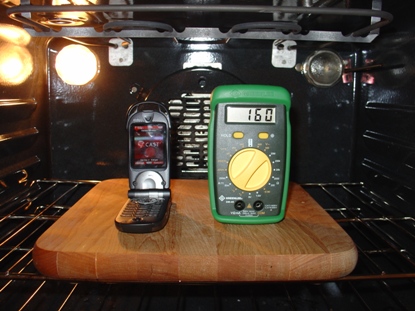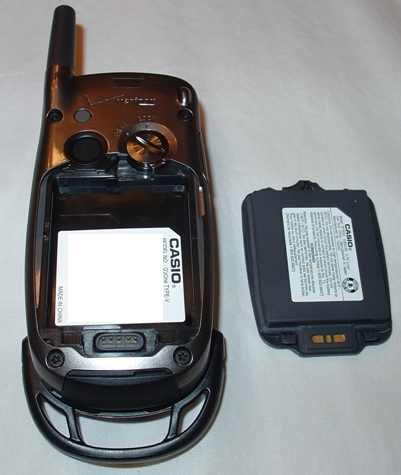

Stress-testing and review of the Verizon G'zOne
[This article reviews the first-generation G'zOne. Also click to see a similar review of a heavy-duty phone, the G'zOne Brigade.] Computers don't worry. Electronics don't have stress-related conditions, like high-blood pressure and anxiety. That is, they didn't, until they met me. It's one thing to do the usual cellphone test and analysis, we've all read that before. It's another thing to preheat an oven, take a cellphone, place it gently inside, close the door, and wait. Cook, baby, cook. Hardware reviews have never been so much fun. I had an opportunity to review the G'zOne Type-V cellphone from Verizon Wireless. Looking through the stats, nothing really jumped out at me, and I wasn't particularly excited until I read the phrase "..compliant to multiple military standards." For lack of better words: Ooo! The G'zOne ("gee zee one") is designed to be abused. And that's exactly what I did for this review. Yes, it's a Verizon VCast-capable phone, enabling music and video playback. Sure, there's a built-in camera for pictures and video, voice-activated dialing, speakerphone, instant messaging, and a bunch of other stuff pretty standard among Verizon's newer cellphones, and, frankly, it's all not nearly as cool as knowing you can dunk it under water! Submerge that sucker. Expose it to extremely high temperatures, dirty environments and storm conditions. The Verizon Wireless' Casio G'zOne Type-V cellphone is an electronic love child between the Incredible Hulk and Jackie Chan. No matter what you do to it, no matter the abuse, it just keeps going, looking cool the whole time. Before we get to the testing, here are some shots of the phone. Leatherman provided for size comparison:
The G'zOne is designed for people with physically demanding jobs (like construction), active hobbies (like hiking and camping), or for any owner who tends to bump, drop or otherwise abuse their cellphone. When I agreed to do this review, my condition was that I get to review the G'zOne by directly testing the claims Verizon made. Here's what Verizon says in their ad text: "Exclusively available through Verizon Wireless in the United States, the G’zOne Type-V is compliant to multiple Military Standards including exposure to temperatures in excess of 140ºF, extreme vibration... [and] conditions set to simulate storm conditions of two inches of rainfall per hour with high winds and submersion in one meter of water." G'zOne Testing For G'zOne tests performed to military standards, scroll to the end of this article. However, for my testing, I wanted non-standard, slightly subjective yet controlled conditions. This chaotic environment gives real-world level variation and a more realistic exposure to the unpredictability that is life. It's also more fun. Disclaimer: I was given special permission by Verizon to stress-test the G'zOne. Verizon and I both agree: DO NOT TRY THIS AT HOME. These tests were performed so that we as consumers can validate Verizon's claims without you having to test them yourself. If you break your own equipment, you're the one responsible. Breaking apart what Verizon advertised, here are the my results of testing the G'zOne: G'ZOne Test 1: Expose the G'zOne to temperatures in excess of 140 degrees Fahrenheit Method: Heat up the oven. Not to just 140 Fahrenheit. "In excess of" means we're going higher. While I didn't want to melt any plastic or rubber, I wanted to make "in excess" count. I took it up to 160 degrees Fahrenheit. Preheated the oven. Placed the phone inside, and let it cook and simmer for ten minutes.
Result: The phone passed with no problem. Once I was able to comfortably pick it up again, everything functioned fine, everything looked fine. G'ZOne Test 2: Expose the G'zOne to extreme vibration Method: Okay, you tell me "extreme vibration" without giving me guidelines, and I'll assume you really mean it: Enter the "EuroStyle" vibrating massager. I ziptied the unsuspecting G'zOne to the massager's percussive attachment, and turned it on "high" for ten minutes. From the phone's perspective, it received a pounding worthy of a quarter-ton Swedish masseuse.
Result: No problems. The G'zOne worked perfectly afterward. G'ZOne Test 3: Storm simulation Method: I took a shower. And I invited the G'zOne to join me. The photo below shows the "G'zBandolier" I created and wore for the occasion. The shower simulated rain conditions, and my rendition of Queen's "Bohemian Rhapsody" simulated blowing wind. (For reasons of demure modesty, I won't go into any more detail for this test. Just take it from me – the phone got very wet.)
Note when bringing the G'zOne to wet conditions: In order for the G'zOne to properly protect itself against moisture, splashing and submersion, the following must be done first:
Result: The G'zOne survived this improvised "cell on a rope" with no problems. I'm guessing the designers from Casio never planned on actual exposure to duck-shaped bars of soap, but life is weird that way. G'ZOne Test 4: Submersion in water Method: I dunked the G'zOne under water for ten minutes. Rubber duckie not normally included, but strongly recommended.
Result: Full survival. G'ZOne Test 5: Toddler attack Method: Not approved by Verizon, I wanted to do more than the above. I wanted to expose the G'zOne to the roughest, toughest conditions possible: The innocent, unassuming cellphone was introduced to my 21-month old daughter, Ally. In a short time, Ally gave that phone a workout worthy of any military standardized test. With a plastic hammer.
Result: The phone may have been emotionally damaged from the encounter, but still worked just fine. And, for the record, the phone is appealing to all ages: Ally had a very difficult time giving it back. G'ZOne physical design The following pictures are close-ups of a few components in the G'zOne that were obviously designed to increase the waterproof factor. Each port (charging, headphone and battery connector) is recessed, and sealed by a rubber connector grommet.
Conclusion Not knowing what to expect from any of the tests, I was fairly tentative at first, treating the phone like the $300 piece of equipment it is. I actually winced during the phone's first dunking underwater, half-expecting to hear an electric short-circuit and see the screen go blank. However, I grew more relaxed as the phone continued to endure test after test with no problems or complaints. It's a nice phone visually, they did a good job on design. And physically? It certainly performs as advertised, no small feat. True, most all cellphones are solid-state, with no moving parts. So the vibration test and similar ones could probably be passed by most cellphones. To me, the water resistance (with this comes dust and dirt resistance) and tough, insulated case design are the most impressive aspects. If you want a phone designed for tough, extreme, dirty, wet or dangerous conditions, I strongly recommend the Verizon G'zOne. The G’zOne Type-V from Verizon Wireless is available for $300 with a new two-year customer agreement. Casio G'zOne TYPE-V Military Standards Testing This information was copied from the G'zOne's press release. The G’zOne Type-V passed all of the following tests, performed in accordance with Military Standards 810°F, with all ports (battery, headset and charging) on the phone closed and the antenna secured:
|
|













